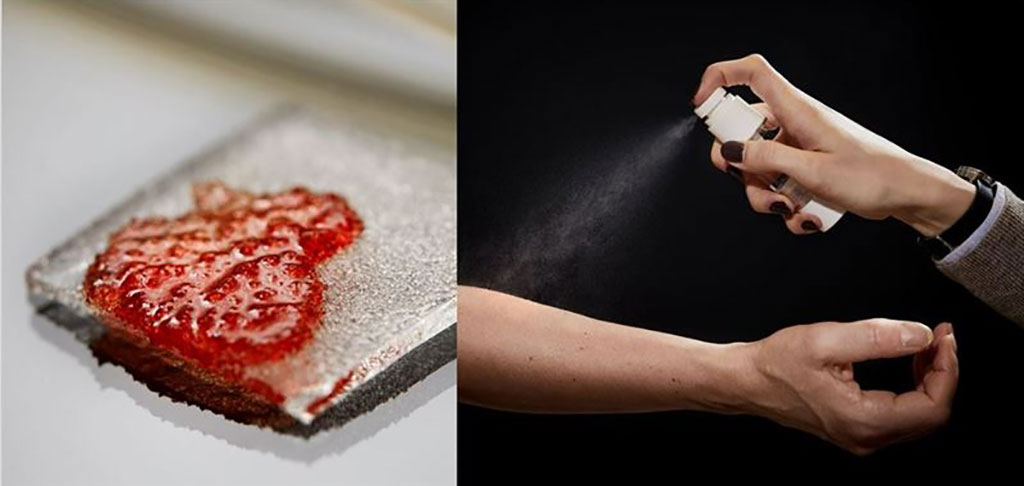Hydrogel-Based Spray Kills Antibiotic-Resistant Bacteria in Wounds and Biomedical Implants
|
By HospiMedica International staff writers Posted on 27 Jan 2023 |

Antibiotic resistance has been ranked among the top ten threats to global health by the World Health Organization (WHO). Antibiotic-resistant bacteria is estimated to cause almost 1.3 million deaths annually across the world. Hence, there is a great need for new solutions to tackle antibiotic-resistant bacteria and reduce the use of antibiotics. Infections are a major problem for treatments in which materials like implants and catheters are inserted into the patient’s body. This makes it vital to develop new antibacterial biomaterials that can treat, replace or modify organs, tissue or functions in a biological body. Now, a group of researchers is developing a new spray that can kill even antibiotic-resistant bacteria, and can be used for wound care as well as directly on implants and other medical devices.
In an effort to slow down the spread and development of drug resistance, researchers at Chalmers University of Technology (Gothenburg, Sweden) are developing a new antibacterial material for use in healthcare settings that can become an effective tool against antibiotic resistance. The material consists of small hydrogel particles that are equipped with a type of peptide that effectively kills and binds bacteria. Attaching the peptides to the particles creates a protective environment and increases their stability, allowing them to work with body fluids such as blood, which otherwise inactivates the peptides and make them difficult to use in healthcare settings.
In previous studies, the researchers had shown how the peptides can be used for wound care materials like wound dressings. Now, in two of their latest studies, the team has shown that the bactericidal material can be used both in the form of a wound spray and as a coating on medical devices implanted in the body. For both the spray and the coating, the researchers measured the bactericidal effect of the materials and found that it can last for up to 48 hours in contact with body fluids and for as long as a few years without contact with body fluids. The researchers also found that the material can kill 99.99% of the bacteria, enabling a wide range of clinical applications. Since the usage of urinary catheters is one of the primary causes of hospital-acquired infection, the researchers tested the coating on silicone materials used for catheters, although it can be also used on other biomaterials. Being non-toxic, the material can also be used directly on or in the body for preventing or curing an infection without any adverse impact on the natural healing process.
“Our innovation can have a dual impact in the fight against antibiotic resistance. The material has been shown to be effective against many different types of bacteria, including those that are resistant to antibiotics, such as Methicillin-resistant Staphylococcus aureus (MRSA), while also having the potential to prevent infections and thus reduce the need for antibiotics,” said Martin Andersson, head of research for the study and Professor at the Department of Chemistry and Chemical Engineering at Chalmers.
“The substance in this wound spray is completely non-toxic and does not affect human cells. Unlike existing bactericidal sprays, it does not inhibit the body’s healing process. The materials, which are simply sprayed onto the wound, can also kill the bacteria in a shorter time,” explained Edvin Blomstrand, PhD student at the Department of Chemistry and Chemical Engineering at Chalmers.
“Although the catheters are sterile when unpacked, they can become contaminated with bacteria while they are being introduced into the body, which can lead to infection. One major advantage of this coating is that the bacteria are killed as soon as they come into contact with the surface. Another is that it can be applied to existing products that are already used in healthcare, so it is not necessary to produce new ones,” added Annija Stepulane, PhD student at the Department of Chemistry and Chemical Engineering at Chalmers.
Related Links:
Chalmers University of Technology
Latest Critical Care News
- Pulse Oximeter Index Offers Non-Invasive Guides for Fluid Therapy
- Wearable Patch for Early Skin Cancer Detection to Reduce Unnecessary Biopsies
- 'Universal' Kidney to Match Any Blood Type
- Light-Based Technology to Measure Brain Blood Flow Could Diagnose Stroke and TBI
- AI Heart Attack Risk Assessment Tool Outperforms Existing Methods
- Smartphone Imaging System Enables Early Oral Cancer Detection
- Swallowable Pill-Sized Bioprinter Treats GI Tract Injuries

- Personalized Brain “Pacemakers” Could Help Patients with Hard-To-Treat Epilepsy
- Microscopic DNA Flower Robots to Enable Precision Medicine Delivery
- Origami Robots to Deliver Medicine Less Invasively and More Effectively
- Improved Cough-Detection Technology Aids Health Monitoring
- AI Identifies Children in ER Likely to Develop Sepsis Within 48 Hours
- New Radiofrequency Therapy Slows Glioblastoma Growth
- Battery-Free Wireless Multi-Sensing Platform Revolutionizes Pressure Injury Detection
- Multimodal AI to Revolutionize Cardiovascular Disease Diagnosis and Treatment
- AI System Reveals Hidden Diagnostic Patterns in Electronic Health Records
Channels
Surgical Techniques
view channel
Robotic Assistant Delivers Ultra-Precision Injections with Rapid Setup Times
Age-related macular degeneration (AMD) is a leading cause of blindness worldwide, affecting nearly 200 million people, a figure expected to rise to 280 million by 2040. Current treatment involves doctors... Read more
Minimally Invasive Endoscopic Surgery Improves Severe Stroke Outcomes
Intracerebral hemorrhage, a type of stroke caused by bleeding deep within the brain, remains one of the most challenging neurological emergencies to treat. Accounting for about 15% of all strokes, it carries... Read morePatient Care
view channel
Revolutionary Automatic IV-Line Flushing Device to Enhance Infusion Care
More than 80% of in-hospital patients receive intravenous (IV) therapy. Every dose of IV medicine delivered in a small volume (<250 mL) infusion bag should be followed by subsequent flushing to ensure... Read more
VR Training Tool Combats Contamination of Portable Medical Equipment
Healthcare-associated infections (HAIs) impact one in every 31 patients, cause nearly 100,000 deaths each year, and cost USD 28.4 billion in direct medical expenses. Notably, up to 75% of these infections... Read more
Portable Biosensor Platform to Reduce Hospital-Acquired Infections
Approximately 4 million patients in the European Union acquire healthcare-associated infections (HAIs) or nosocomial infections each year, with around 37,000 deaths directly resulting from these infections,... Read moreFirst-Of-Its-Kind Portable Germicidal Light Technology Disinfects High-Touch Clinical Surfaces in Seconds
Reducing healthcare-acquired infections (HAIs) remains a pressing issue within global healthcare systems. In the United States alone, 1.7 million patients contract HAIs annually, leading to approximately... Read moreHealth IT
view channel
Printable Molecule-Selective Nanoparticles Enable Mass Production of Wearable Biosensors
The future of medicine is likely to focus on the personalization of healthcare—understanding exactly what an individual requires and delivering the appropriate combination of nutrients, metabolites, and... Read moreBusiness
view channel
Philips and Masimo Partner to Advance Patient Monitoring Measurement Technologies
Royal Philips (Amsterdam, Netherlands) and Masimo (Irvine, California, USA) have renewed their multi-year strategic collaboration, combining Philips’ expertise in patient monitoring with Masimo’s noninvasive... Read more
B. Braun Acquires Digital Microsurgery Company True Digital Surgery
The high-end microsurgery market in neurosurgery, spine, and ENT is undergoing a significant transformation. Traditional analog microscopes are giving way to digital exoscopes, which provide improved visualization,... Read more
CMEF 2025 to Promote Holistic and High-Quality Development of Medical and Health Industry
The 92nd China International Medical Equipment Fair (CMEF 2025) Autumn Exhibition is scheduled to be held from September 26 to 29 at the China Import and Export Fair Complex (Canton Fair Complex) in Guangzhou.... Read more














